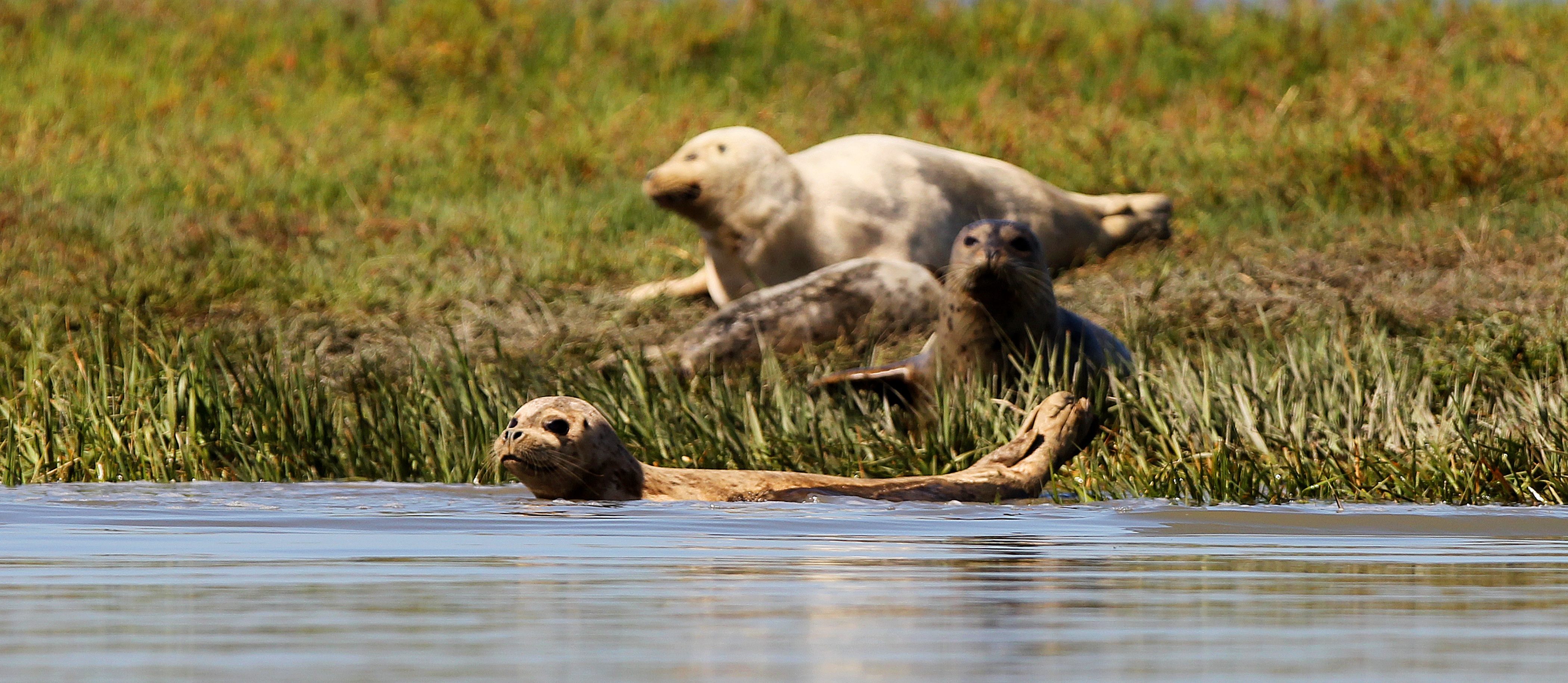By Julia Foote
 Photo credit: Harbor seals in Mowry Slough, adjacent to Area 4 by Aric Crabb, courtesy of Save Newark Wetlands.
Photo credit: Harbor seals in Mowry Slough, adjacent to Area 4 by Aric Crabb, courtesy of Save Newark Wetlands.
On a gray Friday morning in November 2019 (back in those glorious pre-pandemic days), a staffer from Greenbelt Alliance and I were scooped up from the Fremont BART station by two advocates from Citizens Committee to Complete the Refuge. We had an early meeting with the Mayor and City Manager of Newark to discuss a proposed luxury housing development on a restorable wetland along the San Francisco Bay shoreline at Newark’s “Area 4” site. The 469-unit luxury housing project in question would pave over hundreds of acres of open space directly adjacent to the Don Edwards SF Bay National Wildlife Refuge. 100,000 truckloads of fill would be dumped atop restorable wetlands within a 100-year FEMA flood zone that is anticipated to be completely inundated by sea level rise. There is no universe in which this project makes sense; but for profit-hungry developers and city government, we have to be convincing.
The case for protecting Area 4 is clear. This 559-acre site of historic SF Bay wetlands has been identified as a key opportunity for nature-based adaptation for sea level rise — as a rare space for wetlands to migrate upland, providing critical habitat for endangered wildlife and flood protection for the community in the decades to come.
However, something deeply troubling happened while making our case that day in November. Unexpectedly and unironically, we had to define the terms “wetland,” “ecosystem,” and “ecosystem services” to the Mayor and City Manager so that they could follow our argument. I walked out of that meeting appalled that people who did not have the knowledge to understand the consequences of their actions would be able to make such permanent, destructive decisions.
One month later, the City of Newark approved the development. I felt the familiar sting of environmental advocates, frontline communities, and members of my generation not being heard; all for short-term gains for people who don’t care to understand what they destroy and what future they create.
Legal efforts by environmentalists to challenge the environmental review of the Area 4 development so far have been unsuccessful. Now we are pressuring the Bay Conservation and Development Commission (BCDC) and the SF Bay Regional Water Quality Control Board, agencies responsible for protecting the Bay, to step in and exert the full extent of their regulatory authority to protect Area 4.
The Newark Area 4 issue is a clear example of why we need regional collaboration to address rising seas. Much of the responsibility to adapt to rising sea level currently lies at the city or county level, but local initiatives to adapt to sea level rise will not be enough to solve a regional problem.
Moreover, in a closed Bay system, anything that happens on one part of the shoreline impacts the whole shoreline, so local actions can cause unintended flood impacts to neighboring cities. A localized approach would likely cause disproportionate impacts to under-resourced communities as they struggle to mitigate and adapt to the impact of sea level rise on jobs, businesses, and homes. Without regional collaboration we could see near-term loss of wetlands — the ecosystems most at risk of flooding. Localities will also be more likely to delay addressing sea level rise due to pressing concerns like housing and transportation with a lack of incentive to work across jurisdictions for multi-benefit, nature-based solutions.
BCDC has responded to this issue with Bay Adapt, “an initiative to establish regional agreement on the actions necessary to protect people and the natural and built environment from rising sea levels.” Alongside a wide variety of agencies and stakeholders, the Sierra Club is engaging in Bay Adapt to identify, deliberate, and commit to a set of shared actions in a “Joint Platform” that aims for the Bay Area to adapt better and faster to a rising Bay.
At this stage in the Bay Adapt process, the Sierra Club’s Three-Chapter Sea Level Rise Committee is giving feedback on the Draft Joint Platform of 15 Actions that was released to stakeholders in the fall. Our comments call for:
- Emphasizing the preservation of the ecological health of the Bay in the same way that the platform addresses the needs of shoreline communities and infrastructure.
- Participation of climate scientists, environmental scientists, and biologists in implementing the Bay Adapt platform.
- The protection and enhancement of biological resources to be included in the performance metrics that measure success towards regional goals.
- Initiatives to educate local leaders and government officials about the ecological health of the Bay, and how their land use decisions impact the health of the Bay.
- A regional permitting system that considers regional cumulative impacts in adaptation planning and prioritizes permitting for nature based projects with significant environmental benefits and wetland restoration.
- Meaningful involvement of environmental advocates, community based organizations, and environmental justice organizations.
We expect BCDC to hold a public forum on this platform in the coming months and we will need advocates for these asks on our side! Please reach out to julia.foote@sierraclub.org if you’re interested in being an advocate with us on this regionally significant process for a healthy Bay ecosystem.